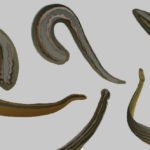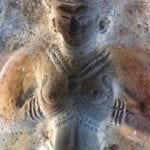 Miscellaneous
Miscellaneous  Miscellaneous
Miscellaneous  Our World
Our World 10 Green Practices That Actually Make a Difference
 Humans
Humans Ten Historic Men Who Deserve Way More Credit Than They Got
 Movies and TV
Movies and TV The 10 Most Heartwarming Moments in Pixar Films
 Travel
Travel Top 10 Religious Architectural Marvels
 Creepy
Creepy 10 Haunted Places in Alabama
 History
History Top 10 Tragic Facts about England’s 9 Days Queen
 Food
Food 10 Weird Foods Inspired by Your Favorite Movies
 Religion
Religion 10 Mind-Blowing Claims and Messages Hidden in the Bible Code
 Facts
Facts 10 Things You Never Knew about the History of Gambling
 Miscellaneous
Miscellaneous Ten Groundbreaking Tattoos with Fascinating Backstories
 Our World
Our World 10 Green Practices That Actually Make a Difference
 Humans
Humans Ten Historic Men Who Deserve Way More Credit Than They Got
Who's Behind Listverse?

Jamie Frater
Head Editor
Jamie founded Listverse due to an insatiable desire to share fascinating, obscure, and bizarre facts. He has been a guest speaker on numerous national radio and television stations and is a five time published author.
More About Us Movies and TV
Movies and TV The 10 Most Heartwarming Moments in Pixar Films
 Travel
Travel Top 10 Religious Architectural Marvels
 Creepy
Creepy 10 Haunted Places in Alabama
 History
History Top 10 Tragic Facts about England’s 9 Days Queen
 Food
Food 10 Weird Foods Inspired by Your Favorite Movies
 Religion
Religion 10 Mind-Blowing Claims and Messages Hidden in the Bible Code
 Facts
Facts 10 Things You Never Knew about the History of Gambling
Top 10 Ancient Practices Supported By Science
Chinese medicine, holistic therapies, and ritualistic shamanism are often viewed as pseudoscience. But they are actually very ancient practices that have been around for thousands of years. However, due to raised interest worldwide, our scientists are now running huge numbers of research trials to try and discover if there is any truth in these strange areas of knowledge. Because of the advancement in technology, such as brain imaging, we are now able to study the brain patterns of people actively practicing meditation or receiving acupuncture, shedding light on what is happening in the brain and body. Here is a Top 10 rundown of the best scientific research to date.
10Acupuncture

The ancient technique of sticking needles into the skin at strategic points has origins dating back thousands of years, the first documented record being around 100 B.C. It is still widely used in China today to treat the root cause of conditions as opposed to the symptomatic approach of Western medicine. However, acupuncture is gaining recognition fast in the West with the British National Health Service stating that acupuncture encourages the body to produce pain-relieving endorphins. Acupuncture is now available for free on the NHS in some areas of the United Kingdom.
So, the question is, if the UK NHS are providing acupuncture to patients, surely there must be some clinical evidence to prove its efficacy? There is! There are over 3000 clinical trials studying the benefits of acupuncture in a vast array of illnesses and conditions. For example, the British Acupuncture Council says obesity has been studied in numerous acupuncture trials with positive results.
A pain management review of acupuncture was published by Manyanga et al. in 2014.[1] The review looked at 12 trials comparing acupuncture to standard care in osteoarthritis (plus placebo and no treatment at all). The results showed significant pain reduction, improved mobility, and better quality of life. And the longer the treatment period, the greater the benefits. The review team from Canada concluded that there is evidence to support the use of acupuncture as an alternative to traditional painkillers in people suffering from osteoarthritis.
So, it’s a big tick for acupuncture, as long as you can overcome the horror of hundreds of needles sticking into your skin at one time.
9Meditation

The National Center for Biotechnology Information currently has over 4000 published papers listed for the search phrase “meditation efficacy,” 400 alone over the last year. Although meditation has been practiced for centuries, particularly in Eastern cultures, it is only recently that the effects of meditation are being studied more widely within the scientific community. Specifically within the field of neuroscience. Some studies have shown that meditation produces positive benefits such as more patience, self-confidence, happiness, less judgmental attitude, calmness, release of anxiety and depression, and a general increased comfort with life’s uncertainties. These benefits, in turn, bring more physical vigor and energy for life. Sounds great, but where is the science?
Here is some carried out by a professor of Physiology, a professor of Anesthesiology, and a professor Pharmacology. The aim of the study was to find out the effect of “Osho dynamic meditation” on the stress hormone levels and whether it has any anti-stress effect. Osho was an Indian guru who introduced dynamic meditation to the world in 1970. Dynamic meditation includes several stages—deep, fast chaotic breathing, EXPLODING! (letting it all out), repeating the mantra “Hoo, Hoo, hoo” whilst jumping up and down, ten minutes of silence, and then dancing. Really, it’s true. It is said to decrease aggressive behavior, anxiety, and depression.
The study measured the plasma cortisol levels (stress level indicators) before and after 21 days of meditation. The results showed a significant reduction at trial end. Thus, it was concluded by the team that Osho dynamic meditation did indeed produce an anti-stress effect, which could be attributed to the release of repressed emotions, psychological inhibitions, and traumas. The study team says that dynamic meditation could be used for the improvement of stress, plus stress related physical and mental disorders.
Incredible and almost unbelievable? How about this one: Dr. Zoran Josipovic of NYU has been using functional magnetic resonance imaging (fMRI) to study the meditating brains of Buddhist monks.[2] Neuroscientists believe the brain is split into two networks—the extrinsic and the intrinsic. They do not function at the same time. They switch. The extrinsic network is where everyday tasks originate, like putting the kettle on or taking part in exercise. The intrinsic network or the “default network” as scientists are now dubbing it, is linked with emotions and inner thoughts. It is also the area of the brain where the most activity is seen during fMRI in patients suffering from Alzheimer’s, depression, or autism, indicating that this is the area being attacked by these conditions. So far, study results have shown a clear disconnect between the two brain networks in experienced and proficient meditators such as Buddhist Monks. The hope for the future is that as it is now proven that the intrinsic brain can be purposely isolated from the extrinsic during meditation, it opens up a new pathway of research for various brain disorders.
Happy, meditating monks and a possible future solution for Alzheimer’s? Neuroscientists say yes. So, it appears that meditation might be mind blowing in many positive ways.
8Sound / Music Therapy
 Music is an important part of many people’s lives. It is mood enhancing and can lift your spirits, or can be a more calming, relaxing influence. Research has shown that just listening to music can reduce stress levels and increase production of the antibodies needed to fight off invading viruses and boost the immune system. However, more recent science is proving that music and sound therapy may have a far greater impact on human health than was previously believed.
Music is an important part of many people’s lives. It is mood enhancing and can lift your spirits, or can be a more calming, relaxing influence. Research has shown that just listening to music can reduce stress levels and increase production of the antibodies needed to fight off invading viruses and boost the immune system. However, more recent science is proving that music and sound therapy may have a far greater impact on human health than was previously believed.
Music Director Anthony Holland teamed up with his science colleagues at Skidmore College in 2013, looking at the idea of tuning forks, which cause each other to resonate in unison. They discussed that if finding the right frequency can cause a crystal glass to shatter suddenly, maybe it would be worth investigating if the right frequency could be found to shatter an organism, like a cancer cell for example. Having discovered the magic frequency, in 2015 Novobiotronics published a paper on their lab-based trial on leukemia cells with very promising results. In their findings, they report a 61 percent reduction in cancer cells. It is still early days, but Anthony, a musician at heart, is optimistic that this research could be music to the ears, as well as all other potential cancer dwelling areas of the body.
Ultrasound is a well-known form of sound therapy, but how about histotripsy? Histotripsy is “non-invasive, mechanical tissue ablation”[3] which uses sound energy to blitz cancer cells. The mechanical process of histotripsy is a focused ultrasound causing microbubbles to form under extreme pressure. These bubbles then oscillate furiously creating huge amounts of energy which causes the targeted tissue to normalize. William W. Roberts, M.D., associate professor of Urology and Biomedical Engineering at the University of Michigan, reveals that in their current research, they are looking at how patients suffering with from liver cancer, prostate cancer, congenital heart syndromes, and thrombosis might benefit from histotripsy.
7Energy Healing (Reiki)

Reiki is a Japanese technique for reducing stress and promoting healing. It is the “laying on of hands” and is based on the idea that an unseen life force energy flows through centers called chakras. Sometimes this energy gets blocked, the chakras become unbalanced, and this can be rectified using Reiki.
Slightly too eccentric for some tastes, famous cardiovascular surgeon, Dr. Mehmet Oz brought energy healing into the limelight when he invited Reiki master Julie Motz to treat patients during open heart surgeries and heart transplant operations. Dr. Oz believes “Reiki has become a sought-after healing art among patients and mainstream medical professionals.”
But has it? Is that true? A trial from the University of Arizona compared Reiki against physical therapy to see how it fared with increasing limited range of movement in patients suffering from shoulder pain.[4] The study proved the concept that a ten-minute Reiki session is as effective as manual physical therapy in improving range of movement in patients with painful shoulder limitation. The research team even suggests that it might be beneficial for physical therapists to train in Reiki so that they could reduce the need for manual work on patients!
In Brazil, scientists at the Institute for Integrated and Oriental Therapy in Sao Paulo evaluated the immediate effect of Reiki on abnormal blood pressure after a 30-minute Reiki session. They saw a positive reduction of blood pressure, suggesting Reiki could be used in the control of hypertension.
A further study from Turin, Italy, looked at the effects of Reiki therapy on pain and anxiety in cancer patients attending a day oncology unit. Reiki sessions of 20 minutes showed a reduction of blood pressure, and overall it was considered helpful in improving well-being, relaxation, sleep quality, pain relief, and reducing anxiety. The research team writes that offering Reiki in hospitals could help with patients’ physical and emotional needs.
Hands up who didn’t believe in hands on healing? Hands up those who still don’t!
6Qigong / Tai Chi

The ancient practice of Tai Chi has been growing in popularity over recent years, but in China, this art form (or health and well-being exercise) has been part of daily life for millions of people for thousands of years.
But does it work and what does it do? So far it is commonly accepted that Tai Chi has some fitness and general wellness benefits, particularly in older adults. In 2016, a team of researchers conducted a study into the specific effect of mental attention in an elderly population before and after participating in a 16-week Tai Chi program.[5] Set mental ability tasks that were performed showed a significant improvement in the participants who had committed to the 16-week Tai Chi program.
What about Qigong? Qigong is lesser known than Tai Chi, but it is actually the foundation on which Tai Chi was created. Thus, the principles are similar, focussing on well-being, general health, and improved cognitive function. Earlier in 2017, a German team investigated EEG brain activity during Qigong Training. The EEG imaging clearly showed significant changes in brain activity, concluding that Qigong induces a relaxed, attentive mind, as well as the participant being “centred” (a state of mind different to “mind-wandering”).
5Mantra Chanting

Mantra is a Sanskrit word for “sound tool,” and “Om” (or Aum) is probably the most well-known mantra of them all. Similar to listening to music, where the vibrational frequencies resonate with our brain evoking emotions, it is believed by many cultures and individuals worldwide that the vibrational frequency of a repeated mantra induces movement of both physical and emotional energy, stirring our emotions. But do they actually do anything?
In 2011, a study carried out at the National Institute of Mental Health and Neurosciences, Bangalore, looked into the neurohemodynamic effects of “Om” chanting using fMRI.[6] In this study, they observed a significant deactivation in the limbic system of the brain when the participants were chanting “Om.” The limbic system is the part of the brain responsible for both our higher mental functions and primitive emotions. It includes the amygdala (emotional center) and the hippocampus (home of long-term memory and emotional response). The research team compared their results to those of a different study looking into the neurohemodynamic effect of VNS treatment (vagus nerve stimulation) used to reduce epileptic seizures and to target treatment-resistant depression. Similar observations were recorded in the VNS trial, with significant deactivation of the limbic system. Therefore, the effect of chanting the mantra “Om” is at least equal to electric shock treatment when it comes to creating inner peace and calm. Is that what they call a no-brainer?
4Telepathy and ESP

Have scientists proved that telepathic communication is no longer science fiction? Well, almost. An international research team has developed a way to say “hello” with the mind, by recording the brain signals of a person in India, converting them into electrical brain stimulations, and relaying them to recipients on the other side of the world.[7] It’s telepathy of a fashion using a process called synaptic transmission. EEG is used to record electrical activity by firing neurons in a participant’s brain. The subject’s conscious thoughts are recorded by EEG, decoded by a computer, and emailed to researchers in France. The stimulation is then delivered to three other participants using a process called transcranial magnetic stimulation (TMS) which applies pulses to the recipient’s brain. The recipient and research team are then able to decode the signals into words.
But is that really telepathy? The scientists say not entirely. They prefer to call it the “transmission of information from one brain to another using non-invasive but still physical mechanisms.”
Another study defining telepathy as “the communication of impressions of any kind from one mind to another, independently of the recognized channels of sense” wanted to explore the neural basis of telepathy by examining a “famous mentalist” and another subject with no known special ability. Both performed a set telepathic task whilst undergoing fMRI. The results showed the two participants’ brains were firing in completely different areas, the famous guy showing activation of the right parahippocampal gyrus (which is part of the intrinsic system linked to emotions and inner thoughts), whereas the other guy showed activation of the left inferior frontal gyrus (extrinsic system—where the performance of everyday tasks are handled). The study team says that the findings suggest that the limbic system of the brain is significant in the study of telepathy and further systemic research would be beneficial.
In the 1990s, the CIA famously closed their remote viewing studies which were part of the Stargate program, even though it is still muted that their research turned up some interesting findings. As early as the 1970s, Stanford Research Institute was carrying out research into perception augmentation techniques on behalf of the CIA. In 1975, Stanford concluded in their final report, “Our data thus indicate that both specially selected and unselected persons can be assisted in developing remote perceptual abilities to a level of useful information transfer.”
3Hypnosis

Hypnosis is widely known across the world, usually as an aid to combat addictions like smoking, or to lose weight, or get rid of phobias. It is also popular as a stage act. But research is being done to test the benefits of hypnotherapy and the claim that it helps us to improve our lives. A lot of people are either afraid or don’t believe. Is it mind control? Is it the devil’s work? Or is it a real tool that can be used to improve many aspects of our lives?
In 2007, a research team at Mount Sinai School of Medicine published their trial results showing that the use of hypnosis before surgery in breast cancer patients not only reduced the amount of anesthesia administered during the operation, but also pain, nausea, fatigue, discomfort, and emotional upset at discharge were greatly diminished in comparison with standard procedures. The time and cost of the procedure were dramatically reduced also, and the team concluded that, overall, the present data supports the use of hypnosis with breast cancer surgery patients.
In addition, researchers at Stanford University School of Medicine scanned the brains of hypnotized subjects and could see the neural changes associated with hypnosis. Fifty-seven brains were scanned in total using a guided hypnosis technique used clinically to treat anxiety, pain, or trauma. Altered levels of activity were recorded in distinct sections of the brain, and David Spiegel MD, the study’s senior author, concludes this is confirmation of which parts of the brain are involved in this kind of treatment. Consequently, he enthuses that how we use the mind to control perception and the body can be changed using this very powerful means. He also suggests that it has taken 150 years to acknowledge that the mind has something to do with pain and controlling it. “It is now abundantly clear that we can retrain the brain,”[8] Spiegel writes.
Spiegel and his team are about to begin a new trial looking into the benefits of hypnosis on fibromyalgia. They will be recruiting soon, and participants can apply here.
2Acoustic Levitation

Acoustic or sound levitation has been the stuff of legends since time began. From the pyramids of Giza to Machu Pichu, there has always been speculation as to how they were built, with believers and non-believers disagreeing over whether some form of ancient levitation was involved. However, that debate may be about to change. Argonne National Laboratory has been experimenting with acoustic levitation or “containerless processing method” in order to increase the solubility of molecules used in pharmaceutical drugs. Currently, solubility is low which means that drugs are not as effective as they could be. If they could be transformed into something more soluble, like an amorphous form, efficacy levels would dramatically increase.
Argonne’s revolutionary acoustic levitation trial has achieved just this, creating great optimism for the future. Admittedly, the technique cannot yet move huge slabs of stone, but the small quantities of pure amorphous forms being synthesized can potentially be useful in the optimization of clinical products. Rome wasn’t built in a day, so who knows what the future holds?
How about a larger object? Researchers from the University of São Paulo in Brazil, and Heriot-Watt University in Edinburgh, UK, published a paper in Applied Physics Letters, 2016, describing their acoustic levitation work. They demonstrated that acoustic levitation can levitate spherical objects much larger than the acoustic wavelength in air. The spherical object is a two-inch polystyrene ball which we might not find very impressive, but this demonstration is one of the first to levitate an object larger than the wavelength of the acoustic wave.[9] “At the moment, we can only levitate the object at a fixed position in space,” says Marco Andrade, co-author of the study. “In future work, we would like to develop new devices capable of levitating and manipulating large objects in air.“
Maybe this is this how they built the Pyramids? What did they know that we have forgotten? Scientists are now busy working on it at least, so hopefully we will find out soon.
1Aromatherapy

The term aromatherapy probably evokes an image of a health spa, or those gift sets we get at Christmas from a lovely aunt, but we don’t necessarily want. However, aromatherapy is an ancient method used in Egypt, China, and India for over 6000 years to enhance health and promote feelings of well-being. Our ancient ancestors believed that different scents influenced different systems in the body. For example, lavender scent was thought to relieve stress and calm the body. Lemongrass was used to ward off insects and relieve body aches.
Aromatherapy gained a lot of attention in the 20th and 21st century in therapeutic, cosmetic, aromatic, fragrant, and spiritual use. And its role in mood, alertness, and mental stress became the hot topic amongst the scientific community recently, with some researchers looking at brain activity using EEG patterns and fMRI. Several studies published interesting results such as patients with depression required smaller doses of antidepressants after citrus fragrance treatment, and the scent of orange oil reduced anxiety in dental patients.
How does it work? The complete mechanism of action is still being studied, but put simply, a biological signal is received by receptor cells when a scent is inhaled. The signal goes to the hypothalamus in the brain, which causes the brain to release messengers like serotonin and endorphin—hormones related to pleasure. So there does seem to be some logic.
One of the most recent publications, dated 2017, is from the University of Calabria in Italy, who published their clinical evidence and possible mechanisms of aromatherapy in treating the behavioral and psychological symptoms of dementia in patients with Alzheimer’s.[10] Their results provided substantial evidence for symptom relief of agitation using aromatherapy in dementia patients, and positive effects were seen in the brain. There is also promising evidence for the effectiveness of aromatherapy, more specifically bergamot essential oil, for managing chronic pain associated with Alzheimer’s Disease.
It seems that science is suggesting that lovely smells make us happier, calmer, and more relaxed. So, giving someone a bunch of flowers is not only a loving thing to do, but it also has a positive effect on well-being. It’s official.
Kathryn has lived in “Coconutland” for the past ten years. She was born in “Farmlandshire” where she grew up and was totally oblivious to the existence of places such as South East Asia. Kathryn, (or Katy) has run her own IT business for 12 years which is not very exciting. She also wrote a book about search engines in 1999, worked as a journalist for a glossy holiday magazine—a bit like Country Life but with coconut trees and beaches—and now just writes about everything and anything she finds interesting. When she is not writing, she can be found swimming in the sea, dancing on the sand, or drinking a cold beer.
Read more about ancient medical practices on 10 Secrets Of Ancient Medicine and 10 Bizarre Medieval Medical Practices.








